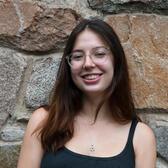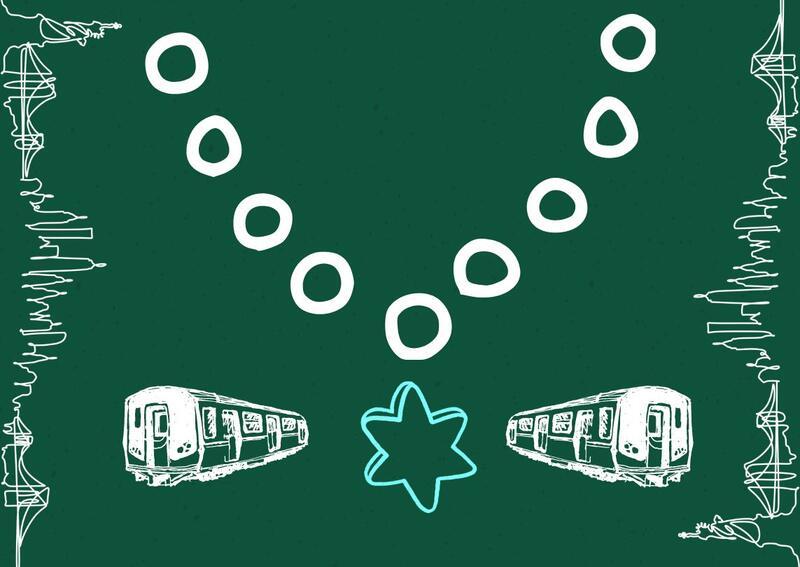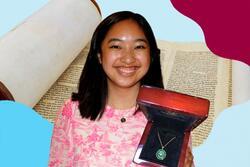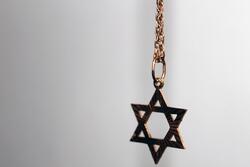Wearing My Star of David Necklace, Loud and Proud
My house has always been filled with what my grandparents call tchotchkes, or assorted trinkets: some with meaning behind them, but many just purchased at a duty-free airport shop or gifted by an acquaintance. We have a handful of Jewish objects, like my parents’ framed ketubah, but other than that, our family never seemed to display anything that proclaimed our Judaism.
In a sense, this came to reflect how I felt about my own religiosity. With a gentile-sounding American last name and only a smattering of Jewish observance, for most of my life I felt uncomfortable demonstrating my Jewishness, like an imposter. Putting on a modest dress and maybe a tallit for synagogue on the High Holy Days felt more like donning a Halloween costume. Since I lived and attended Hebrew school in a very Jewish area of New York City, I would frequently encounter girls my age wearing necklaces with their Hebrew names on them or bracelets with colorful hamsas. Though I always thought the jewelry was pretty to look at, the thought of wearing something that declared my Judaism felt strange. For my twelfth birthday, a Jewish friend of mine gave me a teal hamsa necklace. I thanked her graciously and yet felt averse to wearing it. I hardly attend synagogue, I thought, so what right do I have to wear this religious symbol? I don’t want people to think I’m more Jewish than I am—I shouldn’t try to pretend to be someone I’m not. So the necklace disappeared into a tchotchke-filled drawer somewhere in my closet.
The summer of 2020, it was quarantine, a few months after Covid-19 had shut down schools and practically everything else. August rolled around, half a year after my bat mitzvah, and I still refused to look at any of the pictures of myself from that day. I was in the park with my close friends, sitting six feet apart and drinking a soda. Near us was a group of teenage boys in yarmulkes, singing “Happy Birthday” to a boy sitting in the center of the group. I zoned out and stared at them for a while. They were Jewish, but they were normal kids. They wore yarmulkes, but they were celebrating their friend’s birthday in Central Park like any other friend group might do. Something about their simple presence gave me a strange twinge of jealousy: these boys didn’t feel like imposters when wearing their Jewish garb. Why did I?
On my walk home, I passed by West Side Judaica, a shop I usually strolled by without much more than a glance. But this time, I couldn’t stop thinking about the boys I had passed earlier and how I envied their confidence. I walked into the store and was instantly struck by the sheer amount of stuff. Tchotchkes everywhere. Jewelry, books, little wooden animals, menorahs, dreidels, kiddush cups; they had everything. I was immediately drawn to a rack of necklaces by the register. I peered inside. There were chais, hamsas, Trees of Life —and so many Stars of David. So, so many, of every possible variety and size. The elderly Orthodox man behind the counter opened the case so I could get a better look. We have everything, he proclaimed.
I paused, weighing the benefits and downsides of asking a potentially idiotic question.
“So, would it be, um, weird, if I bought one of these Star of David necklaces? I’m not religious -- I mean, I’m, you know, Jewish, but I just think they’re nice.”
“No,” said the shopkeeper, “not at all. You know, plenty of people in Israel wear them, all the secular men and women.”
“Okay, all right,” I said nervously. I picked out a simple silver one I liked, and without thinking much of it, handed over $50 from my bat mitzvah stash.
Dinner that night was interesting.
“When did you start wearing that?” interrogated my family. “Did I give that to you?”
“No,” I said. “I bought it today.”
“I just think it’s a bit weird to wear a religious symbol, because, you know, we’re not religious,” said my sister.
This made me feel more of an imposter than ever. My Judaism had only ever followed what the rest of my family practiced, and their disapproval made me self-conscious. But I kept the necklace on. Sometimes when I was stressed I would fidget with it. Mainly, I forgot that it was around my neck.
But then there were times when I was reminded. Like that one party where some guy I didn’t know glanced down at my necklace and said, “get that Jew out of here.” Or just a few weeks ago, when I was buying a soda at a deli and the cashier asked me if I was Jewish. “Wow! You’re the first pretty Jew I’ve ever seen,” he said. I walked out laughing. I told my mother, who didn’t find it so amusing. Careful when you wear that, she told me—you might want to tuck it under your shirt on the subways.
But alongside these unpleasant encounters, there have been lovely ones -- like the Russian Jewish women at the barber shop instantly warming up when they saw the glimmering star around my neck, or making instant friends with other Jewish kids in non-Jewish places.
As I’ve grown more comfortable with being visibly Jewish, I have begun to realize that engaging with my religion and culture is a choice that only I can make. And the more I’ve internalized that, the more I’ve realized how my own family makes these choices every day. My dad casually sprinkling Yiddish words into conversation, or my mom humming Avinu Malkeinu while doing the dishes: Jewish culture has been ubiquitous in my family my whole life, even if I couldn’t see it or felt too awkward to participate. My necklace has thus become a talisman for my relationship with Judaism: at times loathing, at times revering—but always, always wrestling.
This piece was written as part of JWA’s Rising Voices Fellowship.








I recently found myself going through old jewelry boxes from when I was a teenager ( 60+ now) looking for a star to wear because I felt the need since Oct 7th to connect on that level as well. Over this Thanksgiving I found the perfect one to connect me, to ground me, to bind me and remind me from where we came and pray where we’ll stay. Happy you found that place as well.